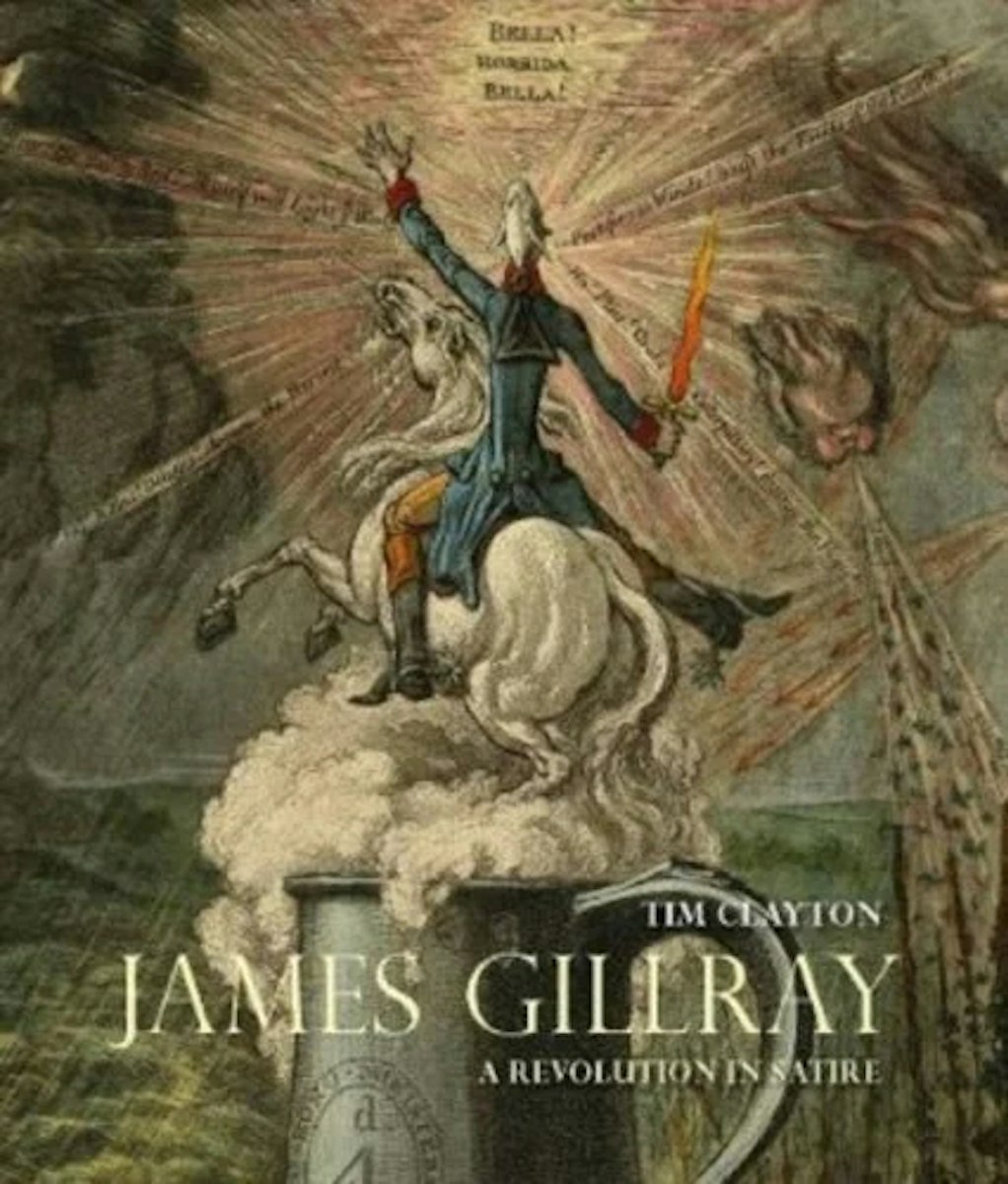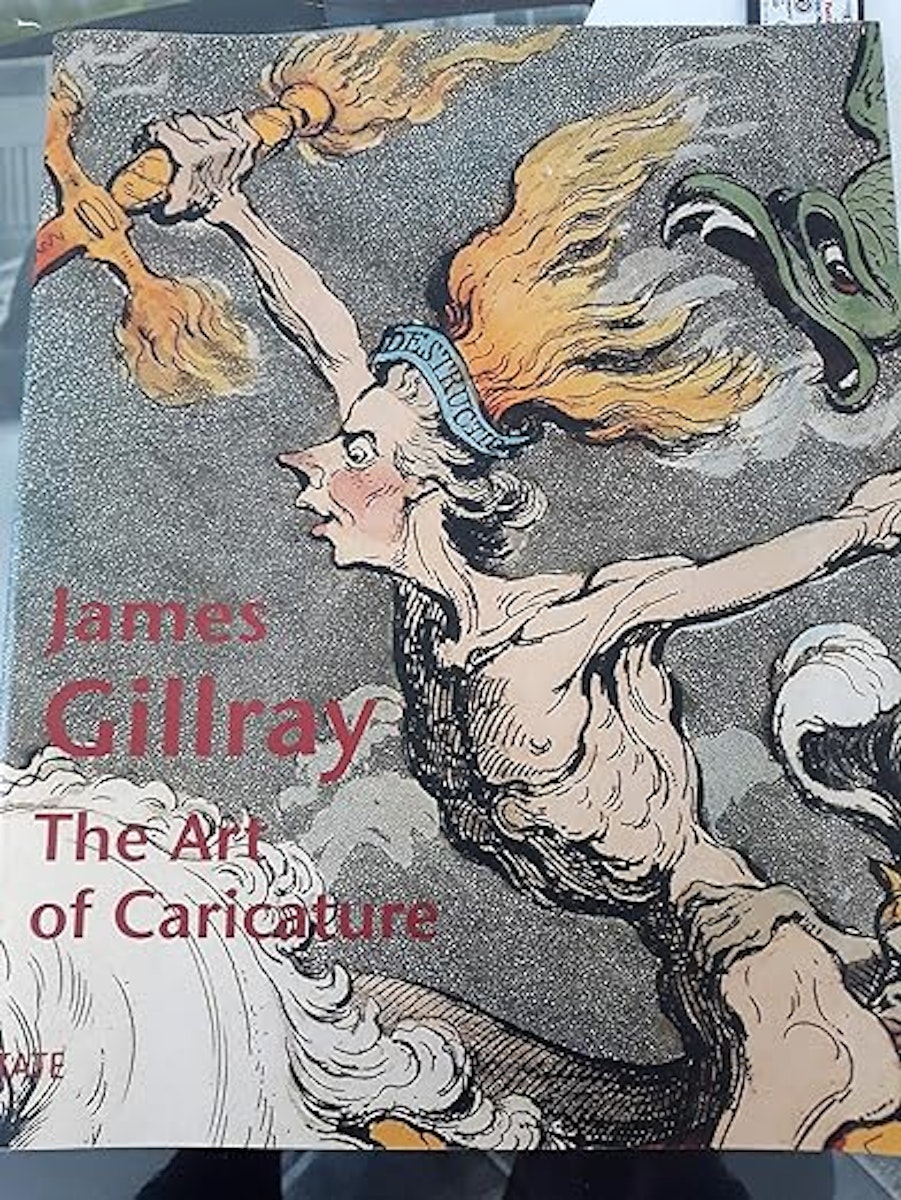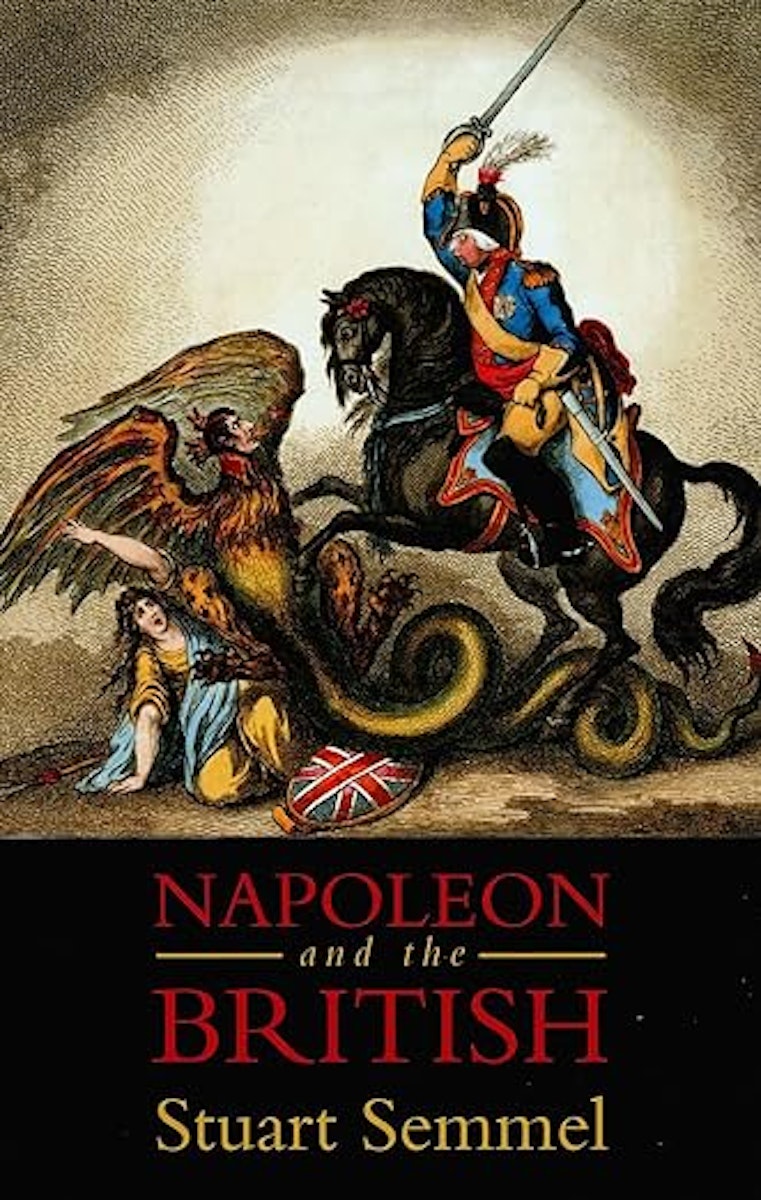
Little Boney James Gillray and Napoleon’s Fragile Masculinity
Of all the caricatures of Napoleon Bonaparte, representations of the French emperor as a miniscule megalomaniac continue to haunt the historical imagination to an unparalleled degree. Peter W. Walker searches for the origins of “Little Boney” in the early 19th-century caricatures of James Gillray, the English illustrator who took Napoleon down a peg by diminishing his reputation and scale to the point of absurdity.
March 21, 2024
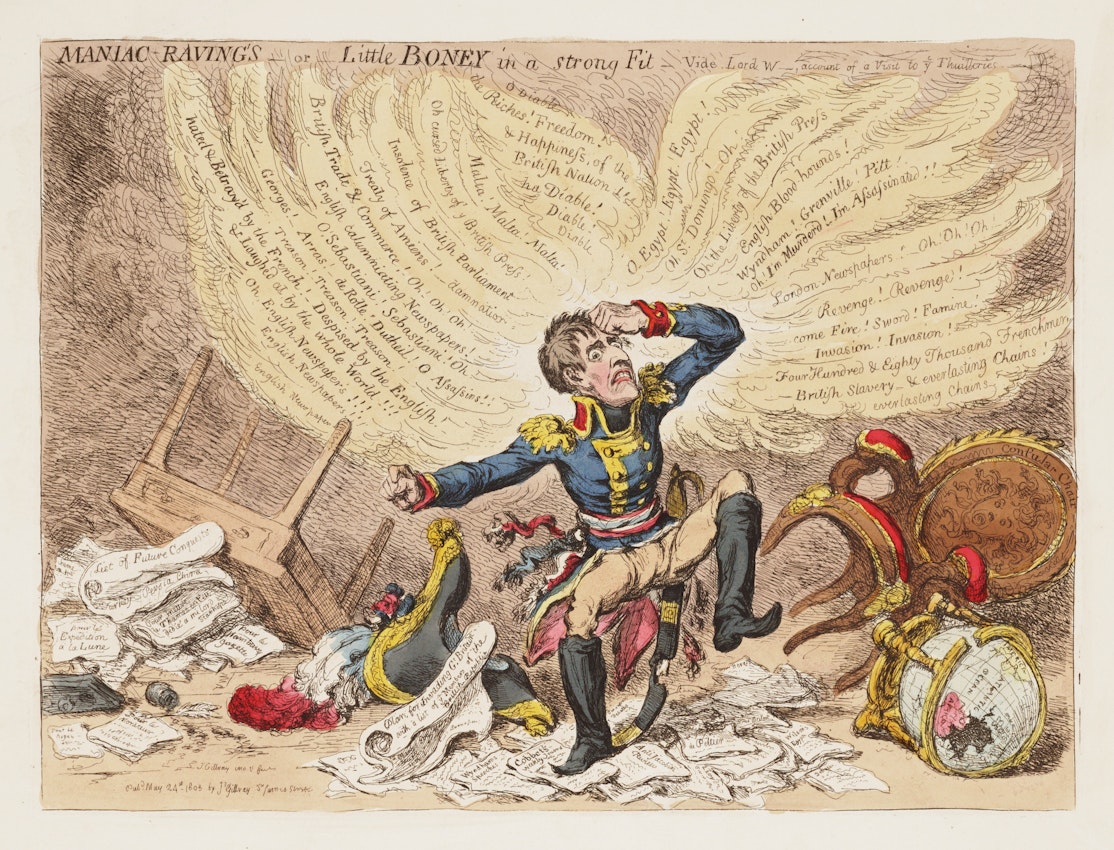 Scroll through the whole page to download all images before printing.
Scroll through the whole page to download all images before printing.James Gillray, Maniac-raving’s, or, Little Boney in a strong fit vide Lord W-, account of a visit to [the] Thuilleries, 1803. Among other lamentations, we find: “Malta! Malta! Malta!”, “London Newspapers! Oh! Oh! Oh!”, “The Riches! Freedom! & Happiness, of the British Nation!!!” — Source.
Napoleon Bonaparte is beloved by a certain kind of military history buff as the epitome of “great man” history: the genius who bends the world to his will. Ridley Scott seems to have aimed for something different with his blockbuster Napoleon (2023). The movie might be read as a study of fragile masculinity, an attempt to reinterpret the “great man” through the lens of twenty-first century sensibilities. Joaquin Phoenix is stiff, insecure, petulant, and terrible at sex. He is above all small: physically, emotionally, metaphorically. His relationship with the Empress Josephine is bizarre. “You think you’re great”, she tells him, “You’re just a tiny little brute who is nothing without me. Say it!” He obeys.
It is not so easy to come up with an original interpretation of someone who has already haunted the European historical imagination for well over two hundred years. In all the above, Scott is echoing contemporaneous British wartime propaganda, whether consciously or not. He is particularly indebted to the brilliant caricaturist James Gillray. Often credited as the “father of the political cartoon”, Gillray created the character of “Little Boney”: a miniscule, cuckolded megalomaniac; a dictator with an inferiority complex. Gillray’s satirical cartoons were so successful, and so funny, that they established an image of Napoleon which remains with us to this day. Scott’s Napoleon is not so different. No wonder that French critics hate it.
Gillray’s determination to take Napoleon down a peg was a response to the emperor’s own prodigious self-aggrandizement. His chameleon-like image is seen in the famous paintings of Jacques-Louis David: a Roman-style military leader in Napoleon Crossing the Alps (1801–05); a modern statesman in The Emperor Napoleon in his Study at the Tuileries (1812); a new Holy Roman Emperor in The Coronation of Napoleon (1807). In the last, he places the imperial crown on his own head, overseen by a compliant Pius VII. (Napoleon had kidnapped the previous Pope, Pius VI, who died in captivity in Paris.) He is legitimized by an ancient, sacred Catholic ceremony, in an overture to France’s still-powerful royalists, even as he undercuts the traditional Christian meaning of a coronation, replacing it with one of meritocracy; he is the heir to Charlemagne, but he got there himself. The emperor scored a still more surprising propaganda victory with Emmanuel de la Cases’ The Memorial of Saint Helena, published in 1823. After he was defeated the first time, Boney was exiled to the Mediterranean island of Elba, but easily escaped. The second time around, he found himself banished to a small rock in the middle of the South Atlantic Ocean named Saint Helena. Here, he dictated his memoirs, rehabilitating his reputation and winning a new generation of admirers. That certain kind of military history buff’s ongoing admiration for Napoleon is a product less of the man’s military or political abilities than of his gift for propaganda.
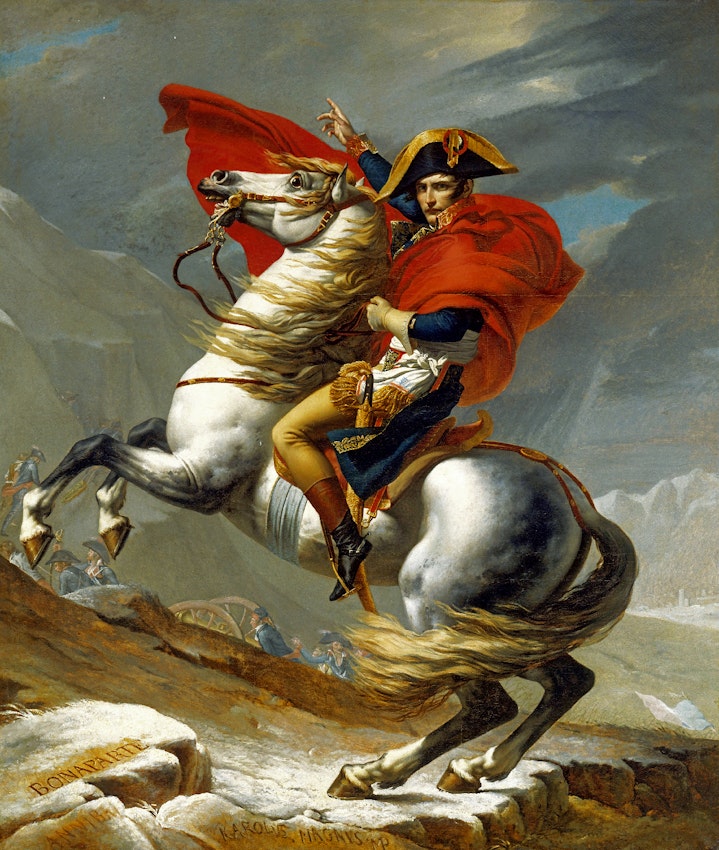 Scroll through the whole page to download all images before printing.
Scroll through the whole page to download all images before printing.Jacques-Louis David, Napoleon Crossing the Alps, 1802 — Source.
-edit.jpeg?fit=max&w=1200&h=850) Scroll through the whole page to download all images before printing.
Scroll through the whole page to download all images before printing.Jacques-Louis David, The Coronation of Napoleon (detail), 1807 — Source.
The “golden legend” of Napoleonic propaganda met its match in Britain’s well-developed tradition of satire and political caricature. Britain enjoyed a climate of relative press freedom, rancorous party politics, and a robust market for the printed word and image: conditions which fostered the work of caricaturists such as the famous William Hogarth (1697–1764). Compared to Hogarth, Gillray’s work was more focused on politics. It was also more shocking (and remains so to this day). Even in the uproarious world of Georgian satire, his cartoons stand out as particularly grotesque (such as his 1799 depiction of The Gout); vulgar (as in 1792’s Fashionable Contrasts, depicting the Duke of York’s marriage to Frederica Charlotte); and occasionally devastating (as in 1793’s The Blood of the Murdered, a pre-Napoleon critique of the French Revolution).
Gillray’s own life was far less colorful than these larger-than-life cartoons would suggest. Born in Middlesex in 1756, his father was a veteran, Chelsea pensioner, and member of the Moravian Brethren, a gloomy Protestant sect. Gillray set out to make a career as a “straight” illustrator, but meeting with little success slipped instead into a less respectable profession as a caricaturist. He spent the 1780s satirizing English politics, treating Whigs and Tories alike with equal cynicism, though eventually falling in with the Tory MP and future Prime Minister George Canning. He lodged with the spinster Hannah Humphrey, who published his cartoons. They came close to marrying on one occasion, but Gillray got cold feet at the church door.
His work on the French and their Revolution propelled this colorless man into celebrity. Gillray had good reason to dislike the French: his father had lost an arm during an earlier war with them. Gillray himself accompanied another artist to France in 1793 to make sketches for a painting of the Siege of Valenciennes. Thereafter, he increasingly turned his sights on the Parisian mob (the sans-culottes) and their English sympathizers. The resulting cartoons were extraordinarily popular. In 1802, one royalist French émigré described the “veritable madness” when a new Gillray drawing appeared: “you have to make your way in through the crowd with your fists”.1 In Very Slippy-Weather (1808), Gillray depicts an eager crowd assembled to view his prints, displayed in the window of the printer’s shop. (Cartoons such as these were not printed in newspapers but were instead sold directly by the printer.)
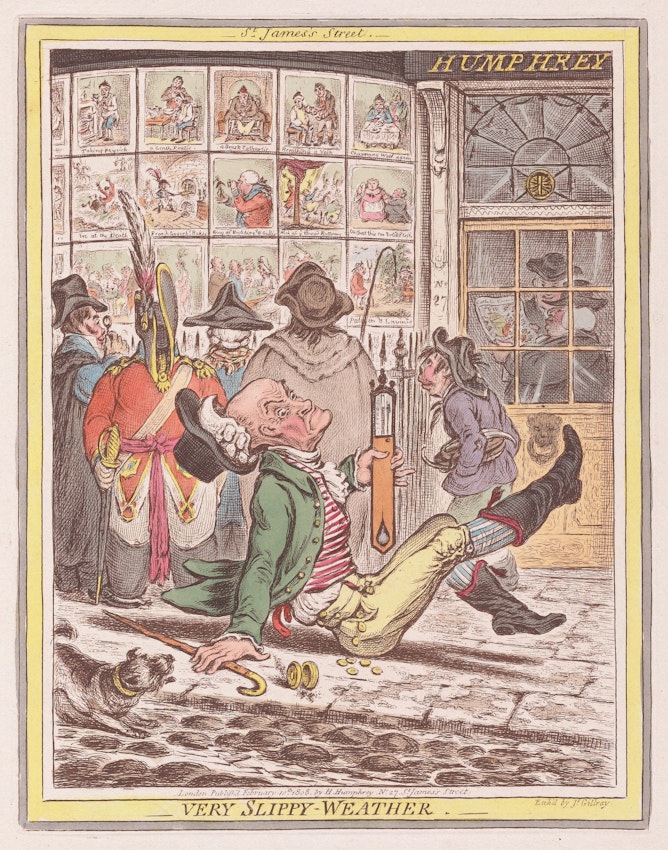 Scroll through the whole page to download all images before printing.
Scroll through the whole page to download all images before printing.James Gillray, Very Slippy Weather, 1808. A range of Gillray’s own prints appear in the window, including The King of Brobdingnag, and Gulliver, discussed below — Source.
There are over two thousand British prints of Napoleon Bonaparte, of which Gillray produced around forty. His were by far the most influential, however, notable for their relentless attacks on Napoleon’s stature. Gillray’s pocket-sized Boney stands in contrast to earlier British caricatures such as Isaac Cruikshank’s The French Bugabo (1797), representing Napoleon as grotesque and monstrous. Gillray’s first caricatures of him are similar. In Buonaparte hearing of Nelson’s Victory (1798), the general is arrogant, disdainful, bloodthirsty, and — at this point — still average-sized.
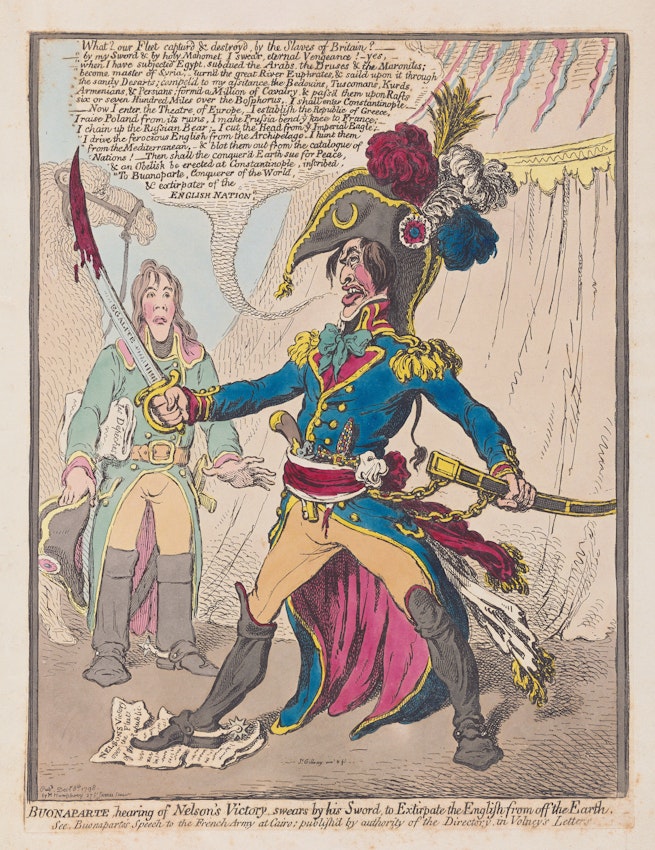 Scroll through the whole page to download all images before printing.
Scroll through the whole page to download all images before printing.James Gillray, Buonaparte, hearing of Nelson’s victory, swears by his sword to extirpate the English from off the Earth, 1798. Napoleon’s impassioned soliloquy ends: “Then shall the conquer’d Earth sue for Peace, & an Obelisk be erected at Constantinople, inscribed ‘To Buanoparte [sic] Conqueror of the World, & extirpater of the English Nation’” — Source.
This would change in 1803. The short-lived Peace of Amiens broke down, war resumed, and Britain braced itself for a French invasion. Alongside the military preparations, the invasion scare saw an outpouring of popular loyalism: volunteering, song-singing, the avid consumption of anti-French propaganda. Gillray’s “Little Boney” was born in this context. In that same year, he gets steadily smaller in Introduction of Citizen Volpone, German Nonchalance, Evacuation of Malta, and Maniac Ravings, shrinking as the French threat to Britain grew. Buonaparte, 48 Hours after Landing and John Bull Offering Little Boney Fair Play minimized (quite literally) the danger posed by a French invasion. “Little Boney” continued diminishing to the point of absurdity. He becomes an animal in Death of the Corsican Fox (1803); a baby in The Genius of France (1804); and — inevitably — a six-inch Lilliputian in The King of Brobdingnag and Gulliver (1804). Other cartoonists quickly got in on the joke, as in 1803’s Britannia Repremanding a Naughty Boy!, John Bull Teazed by an Earwig, and The King’s Dwarf Plays Gulliver a Trick. One printed collection of patriotic songs was similarly full of bellowing threats against “Boney the Pigmy”.2
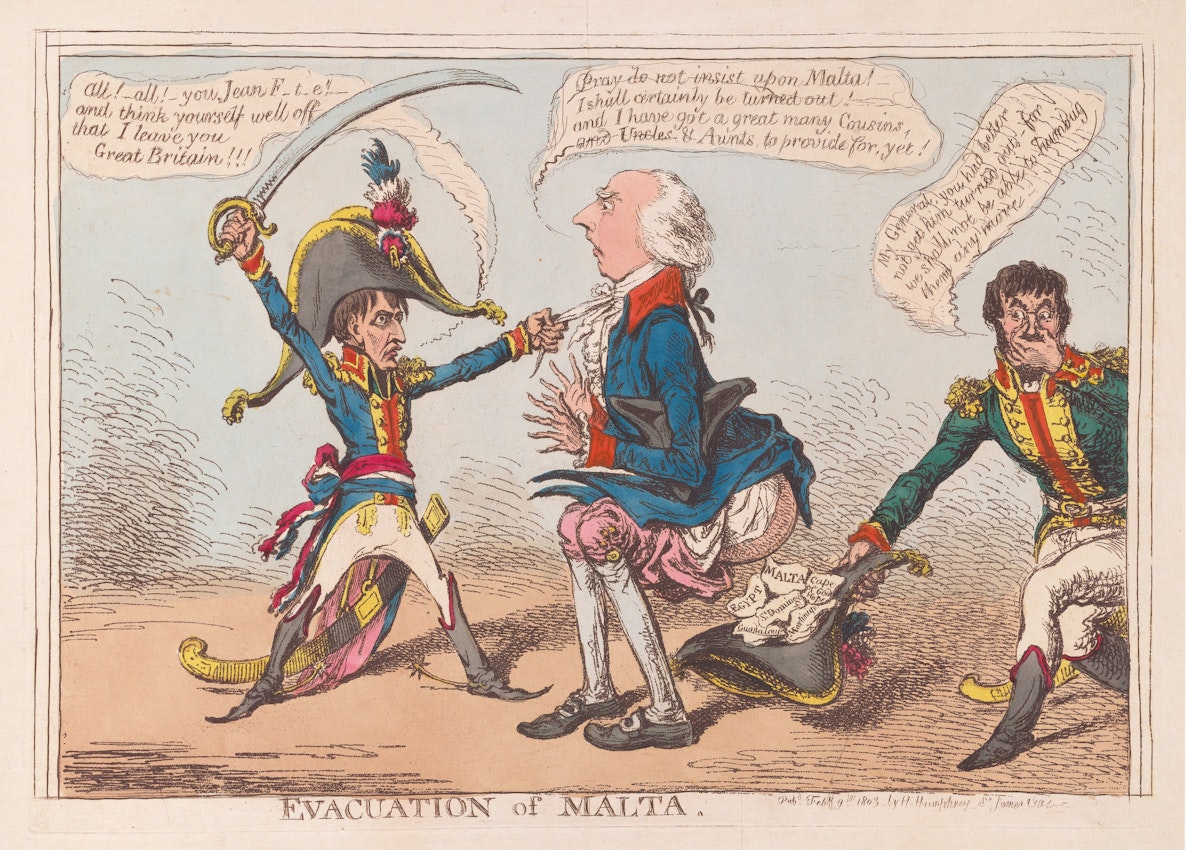 Scroll through the whole page to download all images before printing.
Scroll through the whole page to download all images before printing.James Gillray, Evacuation of Malta, 1803 — Source.
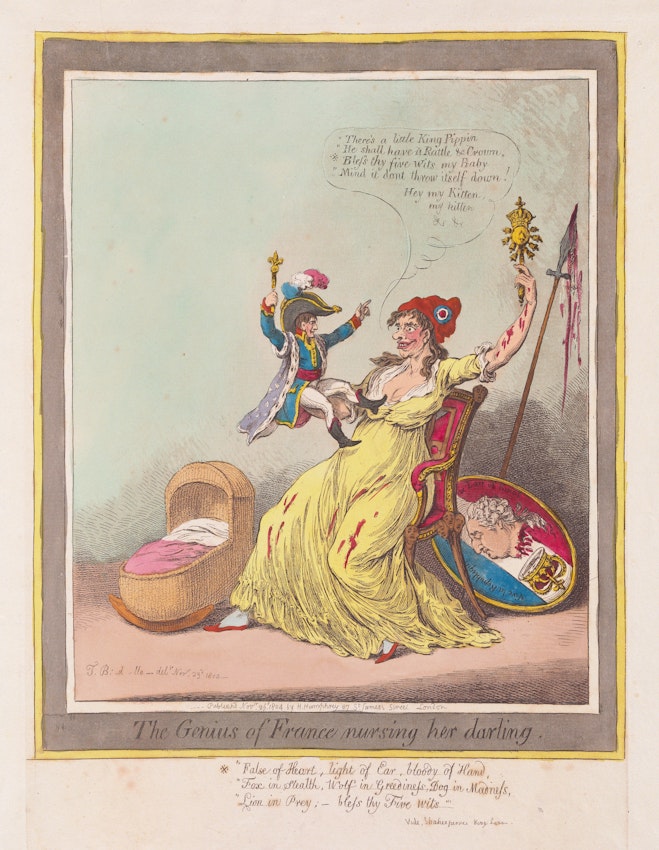 Scroll through the whole page to download all images before printing.
Scroll through the whole page to download all images before printing.James Gillray, The Genius of France nursing her darling, 1804 — Source.
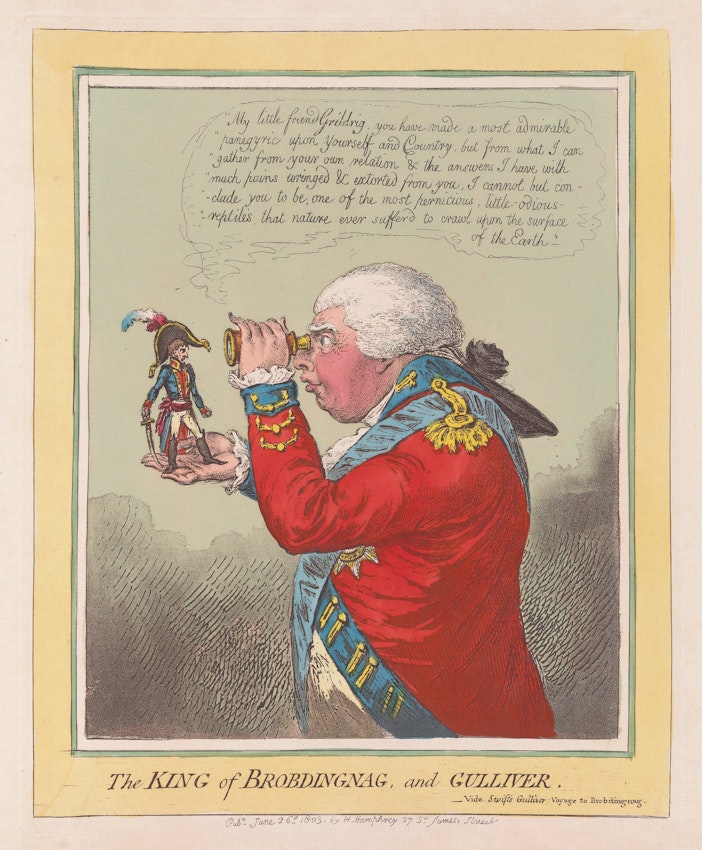 Scroll through the whole page to download all images before printing.
Scroll through the whole page to download all images before printing.James Gillray, The King of Brobdingnag, and Gulliver, 1803. “My little friend . . . I cannot but conclude you to be one of the pernicious, little-odious-reptiles that nature ever suffer’d to crawl upon the surface of the Earth”, says the King of Brobdingnang (George III) to Gulliver (Napoleon) — Source.
Gillray’s tiny Napoleon served, in the first place, to bring a threatening dictator down to size. Charlie Chaplain did much the same thing to Adolf Hitler in The Great Dictator (1940). But Gillray was also mocking Napoleon’s low social origins: he came not from France proper but from a family of minor Corsican nobility. Thomas Rowlandson’s The Progress of the Emperor Napoleon (1808) shows him as a “Ragged Headed Corsican Peasant”. Gillray’s Democracy, or a Sketch of the Life of Buonaparte (1800) begins with his humble, impoverished origins. This was also a joke about Britons’ supposedly higher standard of living. “Little Boney”, as the name implies, is a skeletal figure, whereas Gillray inevitably drew Englishmen as stocky and well fed (dining on French warships in 1798’s John Bull Taking a Luncheon). “Little Boney” was not just a crack at a dictator, but also a class-based attack on the Napoleonic meritocracy and myth of the self-made man.
British cartoonists’ mockery of Napoleon also had a sexual element. They drew him as cuckolded, impotent, and sexually insecure, humiliated by Josephine’s serial infidelities and belittled by his inability to produce an heir. Scott’s Napoleon, with its embarrassing sex scenes, also emphasizes these ideas, but here again Gillray’s cartoons not only got there first but were also far more severe than anything Scott was able to serve up. Gillray’s Ci-devant Occupations (1805) shows Josephine and Madame Talian dancing naked before Napoleon’s rival Paul Barras, while Napoleon himself peeps in from the corner. The scene takes place in Egypt, and the two women appear as orientalized dancing girls, playing tambourines and only half-concealed by a transparent curtain. Josephine, according to the caption, “is smaller & thin, with bad Teeth, something like Cloves”. Similarly, Charles Williams’ The Devil and his Protegée (1810) depicts Napoleon and the Austrian Archduchess Marie Louise on the morning after their wedding night. Holding a copy of the gynecological manual Aristotle’s Masterpiece, Napoleon pleads with the devil for help impregnating his new wife. She adjusts her garter, saying, “few husbands disturb their wives rest more than mine does, but it’s with starting & kicking in his sleep & crying have mercy on me.”
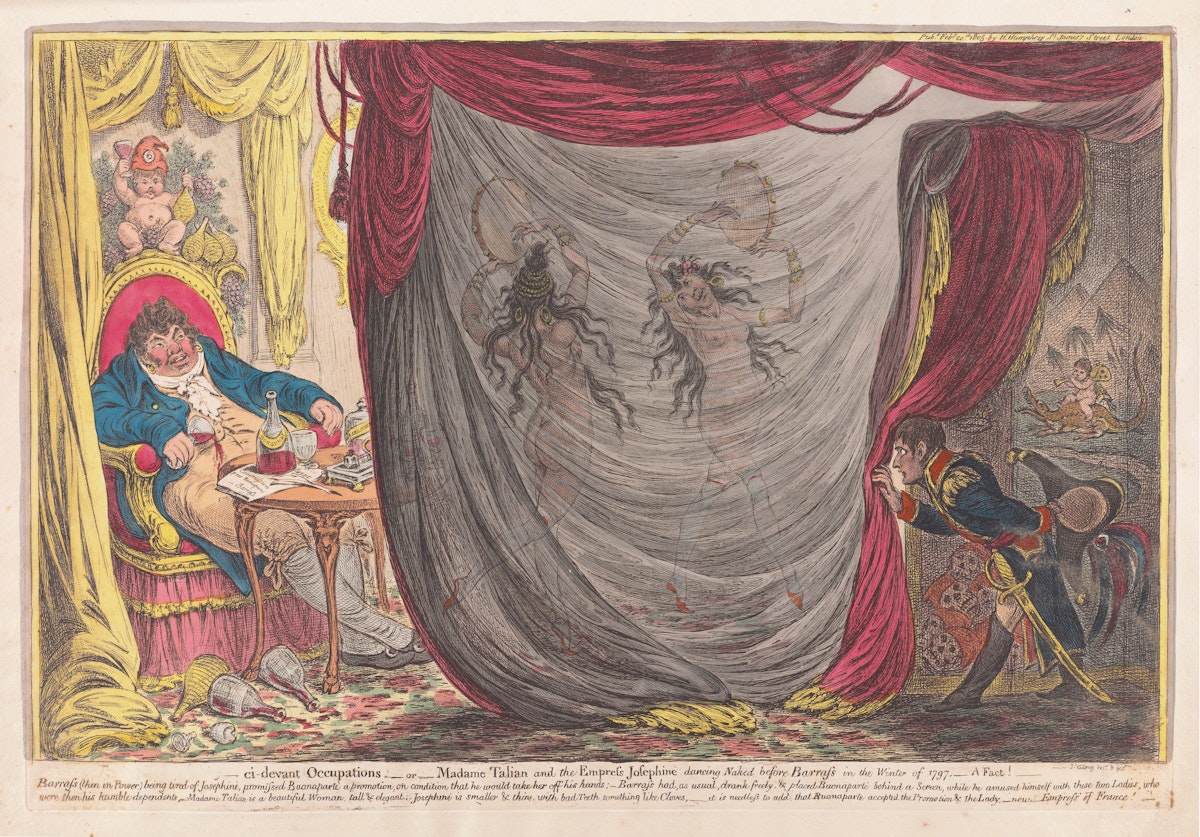 Scroll through the whole page to download all images before printing.
Scroll through the whole page to download all images before printing.James Gillray, Ci-devant occupations, or, Madame Talian and the Empress Josephine dancing naked before Barrass in the winter of 1797, 1805. The caption reads: “[Paul] Barrass (then in Power) being tired of Josephine, promised Buonaparte a promotion, on condition that he would take her off his hands” — Source.
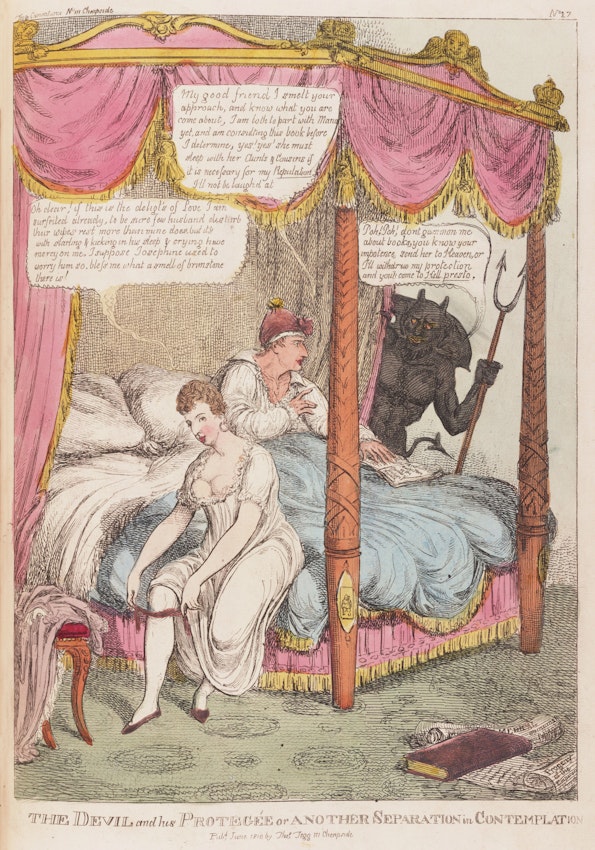 Scroll through the whole page to download all images before printing.
Scroll through the whole page to download all images before printing.James Gillray, The Devil and his Protegée or Another Separation in Contemplation, 1810. The devil says to Napoleon: “Poh! Poh! dont gammon me about books, you know your impotence” — Source.
One of the reasons why these British cartoonists had such fun on this subject is that Napoleon’s sexuality really was public knowledge. As he made the transition from First Consul of the French Republic to a hereditary Emperor of the French, his ability to reproduce — and thus his virility — became a matter of momentous geopolitical significance.3 More concretely, many of his letters to Josephine were intercepted and published during his lifetime. In 1796, he wrote to her from Italy:
I hope that in a few days, I will be more happy . . . to give you proof of the ardent love that you inspire in me. . . . You know well enough that I cannot forget your little visits. You know very well, the little black forest . . . I kiss you there a thousand times and I wait with impatience for the moment I can be there again. . . . Kisses on your mouth, your eyelids, your shoulder, on you everywhere, everywhere!
Within the month, he had discovered her affair with the army officer Hippolyte Charles, and wrote again, “I no longer love you. On the contrary I detest you” (conveniently forgetting his own infidelities).4 British newspapers of the time were not so far removed from today’s tabloids, and they gleefully printed letters such as these, making their author the subject of ridicule.
Gillray’s diminutive and domineering “Little Boney” set the stage for an obsession with Napoleon’s psyche that would last through to the present day. Napoleon gives his name to a psychological disorder (of questionable veracity), the “Napoleon Complex”, which holds that short men are more likely to be aggressive in order to compensate for their physical shortcomings. Even today, the one thing everyone seems to know, or wants to know, about Napoleon is his height. Scott’s Napoleon plays on the same trope: in one scene, the general climbs on a stool in order to look a mummified Egyptian pharaoh in the eyes.
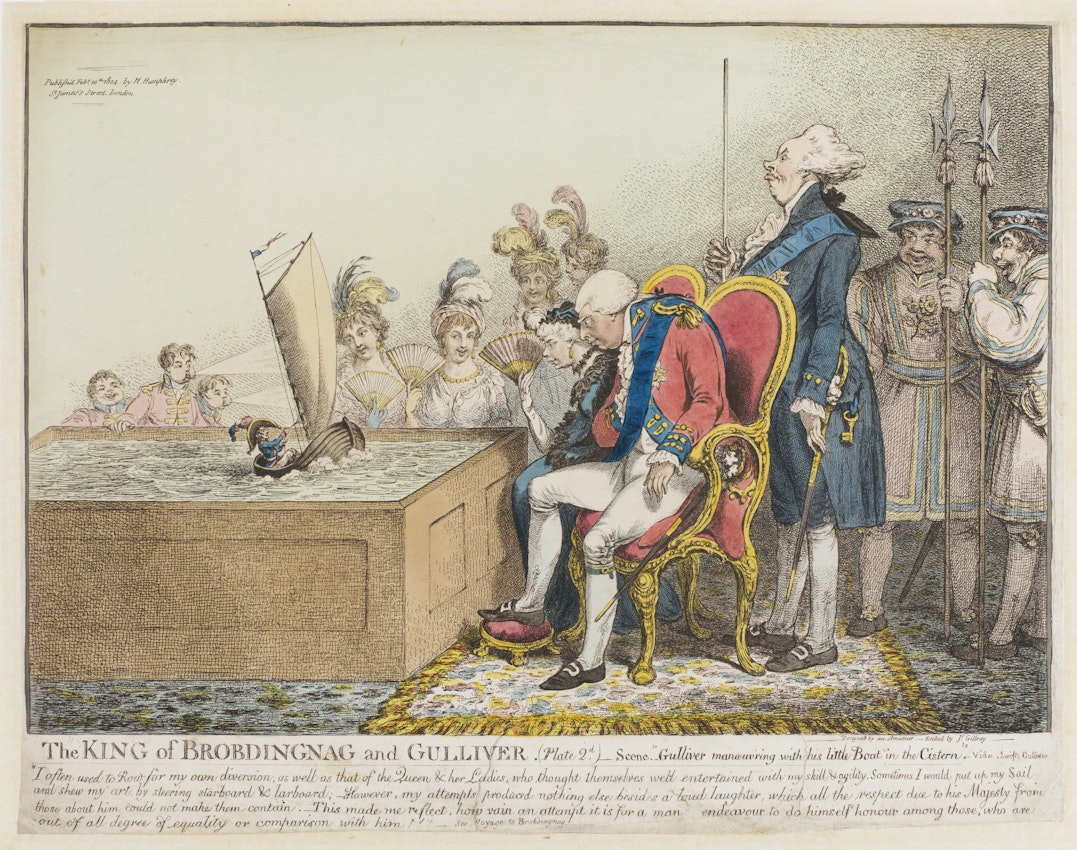 Scroll through the whole page to download all images before printing.
Scroll through the whole page to download all images before printing.James Gillray, The King of Brobdingnag and Gulliver, 1804 — Source.
By focusing relentlessly on psychology, the “black legend” put forward by British cartoonists such as Gillray mirrors the “golden legend” of pro-Napoleon propaganda. While Gillray suggested that Boney’s penchant for world conquest stemmed from a disordered personality, Napoleon depicted himself as a genius who remade Europe’s destiny through the force of his own courage and willpower. That idea has lent itself to the second (also questionable) psychological disorder which bears his name, the “Napoleon Delusion”: the idea that believing oneself to be Napoleon is a hallmark of madness. The idea has proved so influential in popular culture and mass media that a character adopting the distinctive hand-in-jacket pose has become an instantly recognizable shorthand for insanity, employed on Broadway in The Misleading Lady (1913), by Stan Laurel in Mixed Nuts (1922), by Bugs Bunny in Napoleon Bunny-Part (1956), and more recently, by Bender Bending Rodriguez in Matt Groening’s Futurama (2008–2013).
The “golden legend” and the “black legend” are mirror opposites, but they ultimately reinforce one another. The first sees the dictator as the epitome of power and grandeur. The latter sees the dictator as fragile, insecure, and compensatory. Both focus on the dictator’s personality. Together, they lead us back to that certain kind of military history buff and the obsession with “great man” history. Gillray’s cartoons are hilarious, but they imply that dictatorship is a therapist’s problem, to be explained by attention to the Napoleonic psyche. Scott’s Napoleon is more of the same, only less funny. But what of the social and cultural forces that led millions of French men and women to accept, and often enthusiastically celebrate, Napoleonic rule?
Peter W. Walker is an Assistant Professor of History at the University of Wyoming. He is working on a book titled The Power of Suffering: Loyalism, the Church of England, and the American Revolution. He holds a doctorate from Columbia University.





